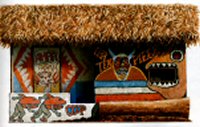The Mahoran Hut |
||
|
|
In Mayotte, culture links puberty with a form of emancipation for the boys. Hence the importance of the hut (or "banga" in Mahorian). As a temporary hut that the boys build around 10/12 years old, the banga metaphorically appears as an initiatic rite, a passage between the young boy pampared by mum-dad (most often by mum, moreover) and the (pimply and thus suspect? ...) adolescent who seeks to see farther than the nipples of mum's breasts. The quest for autonomy, the desire to cut the umbilical cord so early arouses, of course, suspicions - less justified perhaps - among the parents. Awakening to wordly life, awakening of his senses, of his desires, ...and thus suspicions of incest and of God only knows other unnatural offences. That natural blossoming out into a little man, that little mutant body, half docile, half rebellious, takes on something worrying for parents much less in demand. So the boy is helped to build his banga, to mould himself on his own, while, of course keeping an eye on him. Then starts the school of life for the young boy. He begins by modeling his new shelter to reflect his own image.
|
|


